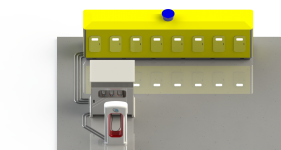herding_cats
Senior Member
- Location
- Kansas
- Occupation
- Mechanical Engineer
We are working on an application with 480vac service, 1600 kW, or 3400 Amp. This is for the Tesla Semi truck charging system.
I know this is insane. I'm coming here to the group to see what you guys recommend to set up in parallel for conductors.
What would be the most cost-effective method to use parallel conductors?
The conduit is PVC, burial, non-conductive so the single wire transformer rule can be used here. Running similar phases in different 4" PVC tubing is possible here without heat build up.
The runs are short. no more than 30'. There are 2-3 90 degree bends, depending, with a 45 here and there. I thought 500 k mil welding cable might be a good choice for the pull. 8 per phase.
The Tesla semi truck charger situation is a mess. Utility companies are routinely denying the permit for this kind of monster service.
I know this is insane. I'm coming here to the group to see what you guys recommend to set up in parallel for conductors.
What would be the most cost-effective method to use parallel conductors?
The conduit is PVC, burial, non-conductive so the single wire transformer rule can be used here. Running similar phases in different 4" PVC tubing is possible here without heat build up.
The runs are short. no more than 30'. There are 2-3 90 degree bends, depending, with a 45 here and there. I thought 500 k mil welding cable might be a good choice for the pull. 8 per phase.
The Tesla semi truck charger situation is a mess. Utility companies are routinely denying the permit for this kind of monster service.

